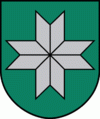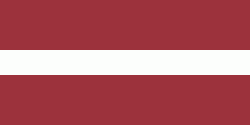Aloja municipality (Alojas Novads)
 |
Aloja Municipality was located in the territory of the North Vidzeme Biosphere Reserve, its rural territories border with the Republic of Estonia, Kocēni, Mazsalaca, Salacgrīva and Limbaži counties. It consisted of the town and parish of Aloja, the town and parish of Staicele, the parish of Braslava and the parish of Brīvzemnieki. There are two small towns in the territory of the county - Aloja and Staicele. In them it is possible to get acquainted with the historical buildings of the end of the 19th century and the beginning of the 20th century, especially the wooden architecture, the Liv cultural heritage of Salaca region.
Distance to the capital Riga - 130 km
* Administrative divisions of Latvia
Map - Aloja municipality (Alojas Novads)
Map
Country - Latvia
 |
 |
| Flag of Latvia | |
After centuries of Teutonic, Swedish, Polish-Lithuanian and Russian rule, which was mainly executed by the local Baltic German aristocracy, the independent Republic of Latvia was established on 18 November 1918 when it broke away from the German Empire and declared independence in the aftermath of World War I. However, by the 1930s the country became increasingly autocratic after the coup in 1934 establishing an authoritarian regime under Kārlis Ulmanis. The country's de facto independence was interrupted at the outset of World War II, beginning with Latvia's forcible incorporation into the Soviet Union, followed by the invasion and occupation by Nazi Germany in 1941, and the re-occupation by the Soviets in 1944 to form the Latvian SSR for the next 45 years. As a result of extensive immigration during the Soviet occupation, ethnic Russians became the most prominent minority in the country, now constituting nearly a quarter of the population. The peaceful Singing Revolution started in 1987, and ended with the restoration of de facto independence on 21 August 1991. Since then, Latvia has been a democratic unitary parliamentary republic.
Currency / Language
| ISO | Currency | Symbol | Significant figures |
|---|---|---|---|
| EUR | Euro | € | 2 |
| ISO | Language |
|---|---|
| LV | Latvian language |
| LT | Lithuanian language |
| RU | Russian language |















